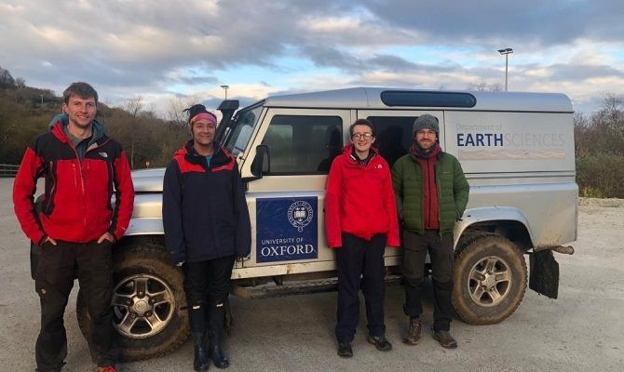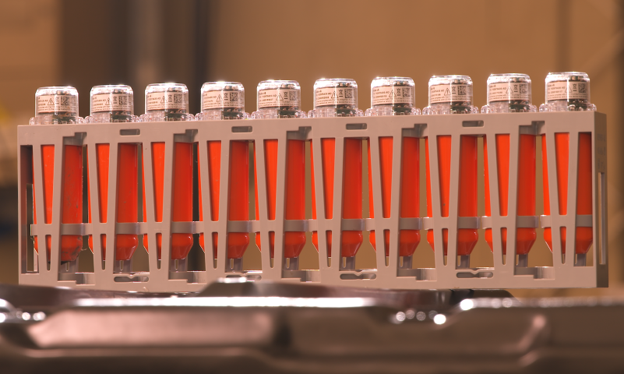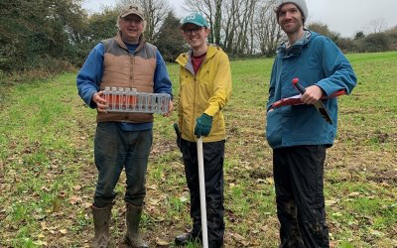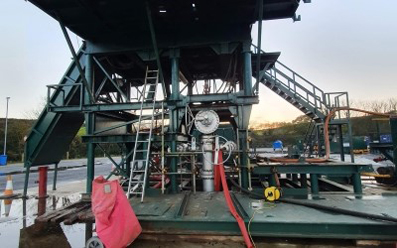Project snapshot
Client: University of Oxford
Goal of the seismic survey: Microseismic monitoring of water injection into a well operated by Eden Geothermal to understand the effect of the injection on Eden's geothermal system and to assess potential interactions with faults.
The University of Oxford was requested to acquire and analyse seismic data during well-testing operations using microseismic processing techniques enabled by a dense deployment of STRYDE Nodes™.

Survey information
Location
UK – Cornwall
Application seismic was acquired for
Monitoring of a water injection on a geothermal well
Survey terrain: Grassland – agricultural terrain
Survey size: 3 km radius around the injection well
Survey type: Continuous passive seismic recording was performed using STRYDE Nodes™. Nodes were deployed 5 days prior to the start of injection to acquire baseline data. Recording continued during injection, and for a period of ~2 weeks post-injection.
Survey layout: The survey design aimed to optimise spatial sampling (azimuths and offsets) of the seismic wavefield around the injection well, and was largely driven by land access constraints due to the large number of landowners in the survey area. The nodes were deployed in various 1C and 3C arrangements, with station spacing varying from 50 m up to 1 km.
Number of nodes deployed: 441 nodes for 28 days
Deployment and retrieval statistics: For node deployment, 2 teams of 2-3 people deployed 441 nodes in 2.5 days, and for retrieval, teams of 1-2 people retrieved 441 nodes in 1 day
How Stryde helped
Technology Supplied
STRYDE supplied the University of Oxford with 450 STRYDE Nodes™ plus the field peripherals required to deploy and retrieve the nodes. STRYDE supplied nodes that were ready prepared for immediate deployment. This reduced operational costs by minimising the amount of time required for deployment operations and by lowering the amount of equipment that needed to be mobilised to the field site.
Upon project completion, the nodes were returned for data harvesting at STRYDE’s facility in Asker, Norway. Final data deliverables were then made available to the University of Oxford via a secure cloud datastore within 2 weeks of receiving the equipment back from the field.

Survey planning
Challenges experienced during survey planning and how STRYDE technology helped overcome these challenges...

Land access
The area surrounding the injection point was home to over 20 private landowners, meaning each landowner had to be individually consulted and educated about the project, technology, and impact this would have on the landowner’s land. This incurred significantly more time than initially planned and resulted in the survey layout having to be modified to ensure livestock and farming operations were not disrupted.

Time constraints
The survey had to align with the operator’s operational plans for injection to capture the baseline data as well as the monitoring data, post-injection. Confirmation of the injection start date was received with only 3 weeks’ notice. This required a joint effort between Oxford and STRYDE to ensure the required inventory was delivered quickly and training was provided in time for the survey start date.

Budget
Budget constraints meant there was a tight budget available to cover the seismic receiver inventory required to conduct the survey. If STRYDE’s low-cost technology solution and flexible commercial model had not been available, the University would have had to complete additional grant applications to fund the project. This would have been incompatible with the well operator’s timeline and so the opportunity to acquire the survey would have been missed.
“Not only did we get access to next-generation seismic instruments, but the contact with experienced seismologists at STRYDE (who clearly understood what instrument characteristics were important for our application), provided advice on how to maximise success on the deployment was a real bonus for us.
The STRYDE Navigator Tablet and App provided location accuracy of node locations for retrieval that was particularly impressive and was essential for retrieving the nodes in what was challenging terrain, and reduced the retrieval time (and therefore cost/man hours) down to 24 hours.
I was especially impressed by the number of instruments we were able to quickly deploy and the per-unit cost which I believe has the potential to revolutionise microseismic studies, even above and beyond other node providers.”
- Tom Hudson, Postdoctoral Researcher, Department of Earth Sciences at The University of Oxford
Benefits of working with STRYDE
The use of STRYDE Nodes™ on this acquisition enabled a magnitude of cost savings and operational efficiency gains, as well as reduced exposure to HSSE risk, and a significant reduction in environmental footprint and land disruption.
Miniature, nonobtrusive equipment
Using the world’s smallest land seismic sensors to acquire this survey made conversations with private landowners easier. Stakeholders were amazed by how small the equipment was and happily granted permission to access and deploy instruments on their land, once they understood how non-intrusive the equipment and survey would be.
Rapid access to seismic tech
Providing access to STRYDE’s seismic sensors within 2 weeks ensured the team at Oxford was able to align with Eden Geothermal’ s operational plans for injection, and meant they were able to successfully capture the baseline data prior to injection and monitor the subsurface thereafter.
Efficient node deployment
Given the tight project timeline, the deployment of the nodes needed to be extremely fast paced. The node’s compact weight and size, combined with stakeless deployment operations enabled by STRYDE’s Navigator Tablet and App, meant that even with a small deployment team 441 nodes could be deployed by foot in just 2.5 days.
Long-lasting battery
It was important to have the nodes in the ground for as long as possible to effectively identify any seismic events that occurred pre, during and post-injection. STRYDE’s autonomous Nodes™ can reliably record continuous data 24 hours a day for 28 days. This enabled seismicity monitoring data to be recorded by the team at Oxford over the entire lifecycle of the geothermal well stimulation operations.
Reduced equipment and operational costs
The STRYDE system has transformed the price point of land seismic equipment relative to the cost of conventional seismic instruments. Furthermore, the ability to deploy the miniature nodes quickly meant planning, preparation, and logistical overheads were greatly reduced, unlocking further cost savings and efficiency gains.
Speedy onboarding and start-up
The simplicity of the STRYDE system means that it is extremely easy to use and is even accessible to people with no previous seismic experience. The Oxford team required only a couple of hours of virtual training to onboard them to the system prior to deployment operations commencing. This allowed the team to start up efficiently and effectively, as was required to comply with the tight operational schedule for fluid injection.
“Due to the tight project turnaround requirements, and because we don’t have a lot of time to dedicate to fieldwork due to other ongoing research projects, we were extremely pleased with how quickly we were able to get access to the technology in such a short period of time, and how easy and quick the nodes were to deploy and retrieve.
I have worked with bulky, and more costly nodal devices before and experienced limitations in terms of quantities we were able to afford, and how quickly they could be deployed. As a seismologist, being able to access and deploy a large number of miniature, low-cost instruments has totally changed the way we do microseismic monitoring, and I am really excited to start working with the data acquired.”
- Tom Kettlety, Research Fellow in Geological Carbon Storage at The University of Oxford
KeyFacts Energy Industry Directory: STRYDE
If your company has an interesting and informative case study to highlight, contact KeyFacts Energy today.
 KEYFACT Energy
KEYFACT Energy